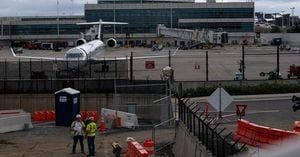As the waters slowly recede in northern Vietnam, the devastation left behind by two successive typhoons has become heartbreakingly clear. Entire communities in provinces like Lạng Sơn, Cao Bằng, Thái Nguyên, and Bắc Ninh have been submerged, with some villages—such as Thôn Tự Nhiên in Vân Nham commune—remaining underwater nearly a week after the storms struck. The scale of the disaster has prompted not only a massive domestic response but also an outpouring of international sympathy, most notably from neighboring Cambodia.
On October 10, 2025, King Norodom Sihamoni of Cambodia sent a heartfelt letter to Vietnamese President Lương Cường, expressing deep condolences and solidarity with those affected by the severe flooding. According to the Vietnamese Ministry of Foreign Affairs, the King wrote, “On behalf of the Cambodian people and in my own name, I would like to extend to you, Mr. President, our heartfelt sympathy, solidarity, and support for those people who have been severely affected by the storm.” He continued, “In this difficult time, we send to you and the brotherly people of Vietnam our sincere condolences and deepest sympathy. From the bottom of my heart, I wish those injured a speedy recovery and hope that people’s lives will soon return to normal.”
This message of support comes at a time when Vietnam is grappling with the aftermath of two destructive storms. Typhoon Bualoi, known locally as storm number 10, formed on September 24, 2025, and swept through the Philippines before making landfall in Vietnam on the night of September 28. The storm unleashed a deadly combination of high winds, torrential rains, and landslides from the North Central region to the mountainous north. The toll was staggering: 26 people lost their lives, and 22 more remain missing, according to official reports cited by VnExpress.
But the ordeal did not end there. Less than a week later, on October 6, storm number 11—Matmo—brought fresh misery to the northern provinces. Torrential rains caused river levels to surge, triggering widespread flooding in areas already battered by the previous storm. The provinces of Cao Bằng, Thái Nguyên, Lạng Sơn, and Bắc Ninh were among the hardest hit. Floodwaters swept away homes and infrastructure, leaving many communities isolated and in desperate need of assistance.
The human and economic costs have been severe. Flooding following the two storms has claimed an additional 14 lives, with four people still unaccounted for. More than 1,560 homes have been damaged or destroyed, and vast swathes of farmland—over 24,100 hectares of rice and other crops—have been inundated. The agricultural sector, a backbone of rural livelihoods, has suffered a staggering blow: 580,000 poultry and nearly 6,700 livestock have perished or been swept away. For families who depend on these resources, the loss is almost unimaginable.
Images from the disaster zones tell a story words can barely capture. In Thôn Tự Nhiên, Vân Nham commune, Lạng Sơn province, rooftops peek above muddy waters, a haunting reminder of how quickly life can be upended. Essential supplies—food, drinking water, and water filters—are being ferried in by relief workers, as captured in photos published by TTXVN. Yet, for many, the road to recovery will be long and uncertain.
Recognizing the scale of the crisis, Vietnamese authorities made an urgent appeal for international support on October 9. Deputy Minister of Agriculture and Environment Nguyễn Hoàng Hiệp described the dire situation on the ground: “We are in great need of essential items such as drinking water, food, and water filters. Restoring homes and production is also crucial, as almost everything has been swept away.” The government’s call for help underscores not only the immediate humanitarian needs but also the challenge of rebuilding livelihoods and infrastructure in the months ahead.
King Sihamoni’s letter is more than a diplomatic gesture—it reflects the deep historical and cultural ties between Cambodia and Vietnam. In times of crisis, such expressions of solidarity remind those affected that they are not alone. “In this difficult time, we send to you and the brotherly people of Vietnam our sincere condolences and deepest sympathy. From the bottom of my heart, I wish those injured a speedy recovery and hope that people’s lives will soon return to normal,” the King reiterated, echoing the sentiments of many Cambodians.
As relief efforts intensify, the Vietnamese government, with support from local and international partners, is working to provide shelter, food, and medical care to displaced residents. Volunteers and aid organizations have mobilized across the affected provinces, delivering supplies to stranded families and helping to clear debris. The focus is not just on immediate relief, but also on restoring homes, replanting fields, and rebuilding the infrastructure that communities rely on.
In the midst of tragedy, there are also stories of resilience and hope. Neighbors have banded together to support each other, sharing what little they have and helping to rescue those trapped by rising waters. Relief workers, some of whom have traveled long distances, are working around the clock to ensure that aid reaches even the most remote villages. These acts of kindness and solidarity offer a glimmer of hope amid the devastation.
For readers seeking a deeper understanding of the region’s challenges and dynamics, Znews has recommended several books on Southeast Asia, including “Competition between China and India in Southeast Asia,” “Cohesion and Proactive Adaptation: Vision and Prospects of ASEAN after 2025,” and “Southeast Asian Studies: Some Issues on Language and Culture.” These works provide valuable context for understanding not only the current disaster but also the broader social, political, and environmental forces shaping the region.
As the floodwaters slowly recede and the full extent of the damage becomes clear, the people of northern Vietnam face an uncertain future. Yet, with the support of neighbors near and far, and the resilience that has long defined their communities, there is hope that recovery—though difficult—will come. The heartfelt message from Cambodia’s King is a reminder that in Southeast Asia, bonds of friendship and solidarity endure, even in the darkest of days.




